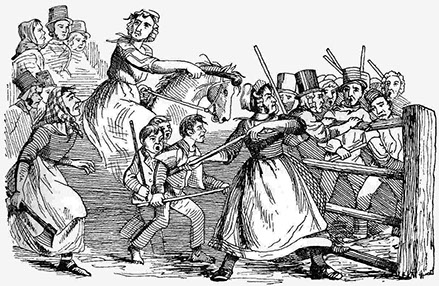
Please Note that this article is the copyright of ©Rhian E. Jones 2018 and may not be copied, printed or used in any way without the permission of the author
‘REBECCA’

The inspiring lecture given by RHIAN E. JONES at the Convention 2017 drew upon her publication Petticoat Heroes (UWP 2015)
CHARTISM e-Mag plans to carry a regular ‘Rebecca’ article in future editions. The Chartist movement, lasted through to the end of the 1850s, and was at its strongest 1838 -1848, when Rebecca peaked between 1842- 44. It is important that consideration is given as to how the two movements co-existed. Rhian’s lecture identified social, attitudinal, tactical differences but also strikingly demonstrated that there was a shared body of values, culture and sense of community held throughout both the rural and the mining communities of southern Wales until at least the 1860s.
When did the ‘Rebecca Riots’ begin?
In May 1839, at the very time that the Chartist leader, Henry Vincent was arrested with three Newport Chartists and charged with holding illegal meetings and making seditious speeches, Rebecca struck. “A toll gate at Efailwen on the Pembrokeshire -Carmarthenshire border was demolished and its tollhouse set on fire. The culprits were a group of men dressed, reportedly, in white ‘smock-frocks’, aprons, shawls, bonnets and petticoats.” (Rhian D. Jones, ‘Occupy the Tollgates: The Rebecca Riots as Myth, Meme and Movement’, Wales Arts Review, 2015).
It was three years before they struck again. It was not until the winter of 1842 and the spring of 1843 that further toll gates were attacked. This pause in ‘Rebecca’ activism has never really been explained.
BUT WHAT IF?
Ivor Wilks commented
“There is no gainsaying the fact that four years separated the peak of Welsh industrial unrest in 1839 from that of peasant unrest in 1843. Those so inclined may wish to contemplate the consequences, had the workers and peasants of Wales marched to precisely the same revolutionary beat in those critical years.” (p251)
Wilks’ observation is one of the many ‘Rebecca -Chartism’ aspects that we intend exploring.
But First, how did RHIAN, who grew up in Tredegar, come to write a book about protest in west Wales?
In 2015, she wrote in the Wales Arts Review:
History in Wales is not so much submerged as sedimentary, with much of it seeming to commemorate only struggle, failure, loss, and things which might have been...
The history of my part of Wales, it seemed, was full of conflict, resistance, opposition – and, apparently, inevitable defeat. While this knowledge helped me to make historical and political sense of myself and my surroundings, it became at the same time a source of fatalism and a certain degree of pique. However inspiring and heroic figures like the Merthyr Rising’s Lewsyn yr Heliwr or the Chartist leader John Frost seemed to me, they were also undeniably tragedies, martyrs, doomed to valiantly dash themselves against the rocks of history, their stories bleak and their endings unhappy. To put it bluntly, the business of popular resistance looked discouragingly like a losing game....
When I looked at the gloomy chronicles of Welsh protest, its single bright spot seemed to originate further afield, not from my own bleak and militant south-east coal and iron belt but from the country’s apparently placid south-west muzzle of Carmarthenshire, Cardiganshire and Pembrokeshire.
The 1840s agricultural unrest known as the Rebecca Riots is remembered as having been an unqualified success and, most famously, as having been carried out on horseback at night by men dressed, for some reason, like our grandmothers....
I spent a chunk of my postgraduate years examining how true this impression was, and discovered a complex but still inspiring picture. After leaving higher education and eschewing academia, I maintained my interest in the Rebecca movement through years of incremental independent study. I now find myself in the vaguely surreal position of bringing out my own book on it.
Taken from her Wales Art Review article published 13/11/2015 to coincide with the launch of ‘Petticoat Heroes’ – and in which Rhian draws parallels between the inspiring Rebecca insurrection of the period and the radical protest movements of the 21st century.
TO READ THE FULL ARTICLE, Go to
http://www.walesartsreview.org/occupy-the-tollgates-the-rebecca-riots-as-myth-meme-and-movement/
RHIAN is speaking SATURDAY 9th JUNE 2018 at the Chartism Day Conference, University College London (UCL) about her book, Petticoat Heroes









